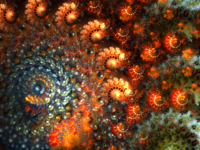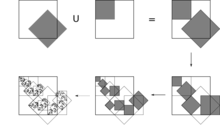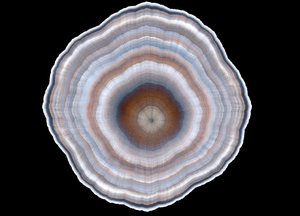“迭代函数系统”的版本间的差异
(Moved page from wikipedia:en:Iterated function system (history)) |
小 (Moved page from wikipedia:en:Iterated function system (history)) |
||
| 第1行: | 第1行: | ||
| − | + | 此词条暂由彩云小译翻译,翻译字数共213,未经人工整理和审校,带来阅读不便,请见谅。 | |
[[File:Sierpinski1.png|thumb|right|250px|[[Sierpinski triangle]] created using IFS (colored to illustrate self-similar structure)]] | [[File:Sierpinski1.png|thumb|right|250px|[[Sierpinski triangle]] created using IFS (colored to illustrate self-similar structure)]] | ||
| 第5行: | 第5行: | ||
[[Sierpinski triangle created using IFS (colored to illustrate self-similar structure)]] | [[Sierpinski triangle created using IFS (colored to illustrate self-similar structure)]] | ||
| − | [[使用 IFS (着色以说明自相似结构) | + | [[使用 IFS 创建的谢尔宾斯基三角形(着色以说明自相似结构)] |
[[File:Chris Ursitti fractal 0000.png|thumb|right|200px|Colored IFS designed using [[Apophysis (software)|Apophysis]] software and rendered by the [[Electric Sheep]].]] | [[File:Chris Ursitti fractal 0000.png|thumb|right|200px|Colored IFS designed using [[Apophysis (software)|Apophysis]] software and rendered by the [[Electric Sheep]].]] | ||
| 第15行: | 第15行: | ||
In [[mathematics]], '''iterated function systems''' ('''IFSs''') are a method of constructing [[fractal]]s; the resulting fractals are often [[self-similar]]. IFS fractals are more related to [[set theory]] than fractal geometry.<ref name="picg">{{cite book |title=Progress in Computer Graphics: Volume 1 |last=Zobrist |first= George Winston |author2=Chaman Sabharwal |year=1992 |publisher=Intellect Books |isbn=9780893916510 |page=135 |url=https://play.google.com/store/books/details?id=Ai6Qo0qoE9EC |accessdate=7 May 2017}}</ref> They were introduced in 1981. | In [[mathematics]], '''iterated function systems''' ('''IFSs''') are a method of constructing [[fractal]]s; the resulting fractals are often [[self-similar]]. IFS fractals are more related to [[set theory]] than fractal geometry.<ref name="picg">{{cite book |title=Progress in Computer Graphics: Volume 1 |last=Zobrist |first= George Winston |author2=Chaman Sabharwal |year=1992 |publisher=Intellect Books |isbn=9780893916510 |page=135 |url=https://play.google.com/store/books/details?id=Ai6Qo0qoE9EC |accessdate=7 May 2017}}</ref> They were introduced in 1981. | ||
| − | In mathematics, iterated function systems (IFSs) are a method of constructing fractals; the resulting fractals are often self-similar. IFS fractals are more related to set theory than fractal geometry. | + | In mathematics, iterated function systems (IFSs) are a method of constructing fractals; the resulting fractals are often self-similar. IFS fractals are more related to set theory than fractal geometry. give surprisingly good image compression, even for photographs that don't seem to have the kinds of self-similar structure shown by simple IFS factals. |
| − | 在数学中,迭代函数系统是构造分形的一种方法; 由此产生的分形通常是自相似的。与分形几何相比,IFS | + | 在数学中,迭代函数系统是构造分形的一种方法; 由此产生的分形通常是自相似的。与分形几何相比,IFS 分形与集合论的关系更大。给出惊人的好图像压缩,即使对于那些似乎没有简单的 IFS 面形所显示的自相似结构的照片也是如此。 |
| 第23行: | 第23行: | ||
'''IFS''' fractals, as they are normally called, can be of any number of dimensions, but are commonly computed and drawn in 2D. The fractal is made up of the union of several copies of itself, each copy being transformed by a function (hence "function system"). The canonical example is the [[Sierpiński triangle]]. The functions are normally [[contraction mapping|contractive]], which means they bring points closer together and make shapes smaller. Hence, the shape of an IFS fractal is made up of several possibly-overlapping smaller copies of itself, each of which is also made up of copies of itself, [[ad infinitum]]. This is the source of its self-similar fractal nature. | '''IFS''' fractals, as they are normally called, can be of any number of dimensions, but are commonly computed and drawn in 2D. The fractal is made up of the union of several copies of itself, each copy being transformed by a function (hence "function system"). The canonical example is the [[Sierpiński triangle]]. The functions are normally [[contraction mapping|contractive]], which means they bring points closer together and make shapes smaller. Hence, the shape of an IFS fractal is made up of several possibly-overlapping smaller copies of itself, each of which is also made up of copies of itself, [[ad infinitum]]. This is the source of its self-similar fractal nature. | ||
| − | + | As of 1995, all fractal compression software is based on Jacquin's approach. | |
| − | + | 截至1995年,所有的分形压缩软件都是基于 Jacquin 的方法。 | |
| 第33行: | 第33行: | ||
Formally, an [[iterated function]] system is a finite set of [[contraction mapping]]s on a [[complete metric space]].<ref>Michael Barnsley (1988). ''Fractals Everywhere'', p.82. Academic Press, Inc. {{ISBN|9780120790623}}.</ref> Symbolically, | Formally, an [[iterated function]] system is a finite set of [[contraction mapping]]s on a [[complete metric space]].<ref>Michael Barnsley (1988). ''Fractals Everywhere'', p.82. Academic Press, Inc. {{ISBN|9780120790623}}.</ref> Symbolically, | ||
| − | + | The diagram shows the construction on an IFS from two affine functions. The functions are represented by their effect on the bi-unit square (the function transforms the outlined square into the shaded square). The combination of the two functions forms the Hutchinson operator. Three iterations of the operator are shown, and then the final image is of the fixed point, the final fractal. | |
| − | + | 该图展示了由两个仿射函数构造 IFS 的过程。函数通过它们对双单元正方形的影响来表示(函数将轮廓的正方形转换为阴影的正方形)。这两个函数的组合形成了哈钦森算子。算子的三次迭代被显示出来,然后最终的图像是不动点的,最终的分形。 | |
:<math>\{f_i:X\to X\mid i=1,2,\dots,N\},\ N\in\mathbb{N}</math> | :<math>\{f_i:X\to X\mid i=1,2,\dots,N\},\ N\in\mathbb{N}</math> | ||
| − | |||
| − | |||
| − | |||
| − | |||
is an iterated function system if each <math>f_i</math> is a contraction on the complete metric space <math>X</math>. | is an iterated function system if each <math>f_i</math> is a contraction on the complete metric space <math>X</math>. | ||
| − | + | Early examples of fractals which may be generated by an IFS include the Cantor set, first described in 1884; and de Rham curves, a type of self-similar curve described by Georges de Rham in 1957. | |
| − | + | 由 IFS 产生的分形的早期例子包括 Cantor 集,第一次描述是在1884年; 和 de Rham 曲线,一种自相似曲线,由 Georges de Rham 在1957年描述。 | |
| 第55行: | 第51行: | ||
[[File:Chaosgame.gif|thumb|right|250px|Construction of an IFS by the [[chaos game]] (animated)]] | [[File:Chaosgame.gif|thumb|right|250px|Construction of an IFS by the [[chaos game]] (animated)]] | ||
| − | + | IFSs were conceived in their present form by John E. Hutchinson in 1981 and popularized by Michael Barnsley's book Fractals Everywhere. <!-- In 1992 Scott Draves developed the Fractal flame algorithm.--> | |
| − | + | 1981年,约翰 · e · 哈钦森以现在的形式构思了 IFSs,并由迈克尔 · 巴恩斯利的著作《分形无处不在》而流行开来。1992年,斯科特 · 德拉维斯发明了分形火焰算法 | |
[[File:Ifs-construction.png|thumb|IFS being made with two functions.]] | [[File:Ifs-construction.png|thumb|IFS being made with two functions.]] | ||
| − | |||
| − | |||
| − | |||
| − | |||
Hutchinson (1981) showed that, for the metric space <math>\mathbb{R}^n</math>, or more generally, for a complete metric space <math>X</math>, such a system of functions has a unique nonempty [[Compact space|compact]] (closed and bounded) fixed set ''S''. One way of constructing a fixed set is to start with an initial nonempty closed and bounded set ''S''<sub>0</sub> and iterate the actions of the ''f''<sub>''i''</sub>, taking ''S''<sub>''n''+1</sub> to be the union of the images of ''S''<sub>''n''</sub> under the ''f''<sub>''i''</sub>; then taking ''S'' to be the [[Closure (topology)|closure]] of the union of the ''S''<sub>''n''</sub>. Symbolically, the unique fixed (nonempty compact) set <math>S\subseteq X</math> has the property | Hutchinson (1981) showed that, for the metric space <math>\mathbb{R}^n</math>, or more generally, for a complete metric space <math>X</math>, such a system of functions has a unique nonempty [[Compact space|compact]] (closed and bounded) fixed set ''S''. One way of constructing a fixed set is to start with an initial nonempty closed and bounded set ''S''<sub>0</sub> and iterate the actions of the ''f''<sub>''i''</sub>, taking ''S''<sub>''n''+1</sub> to be the union of the images of ''S''<sub>''n''</sub> under the ''f''<sub>''i''</sub>; then taking ''S'' to be the [[Closure (topology)|closure]] of the union of the ''S''<sub>''n''</sub>. Symbolically, the unique fixed (nonempty compact) set <math>S\subseteq X</math> has the property | ||
| − | |||
| − | |||
| − | |||
| − | |||
:<math>S = \overline{\bigcup_{i=1}^N f_i(S)}.</math> | :<math>S = \overline{\bigcup_{i=1}^N f_i(S)}.</math> | ||
| − | |||
| − | |||
| − | |||
| − | |||
The set ''S'' is thus the fixed set of the [[Hutchinson operator]] <math>F: 2^X\to 2^X</math> defined for <math>A\subseteq X</math> via | The set ''S'' is thus the fixed set of the [[Hutchinson operator]] <math>F: 2^X\to 2^X</math> defined for <math>A\subseteq X</math> via | ||
| − | |||
| − | |||
| − | |||
| − | |||
:<math>F(A)=\overline{\bigcup_{i=1}^N f_i(A)}.</math> | :<math>F(A)=\overline{\bigcup_{i=1}^N f_i(A)}.</math> | ||
| − | |||
| − | |||
| − | |||
| − | |||
The existence and uniqueness of ''S'' is a consequence of the [[contraction mapping principle]], as is the fact that | The existence and uniqueness of ''S'' is a consequence of the [[contraction mapping principle]], as is the fact that | ||
| − | |||
| − | |||
| − | |||
| − | |||
:<math>\lim_{n\to\infty}F^{\circ n}(A)=S</math> | :<math>\lim_{n\to\infty}F^{\circ n}(A)=S</math> | ||
| − | |||
| − | |||
| − | |||
| − | |||
for any nonempty compact set <math>A</math> in <math>X</math>. (For contractive IFS this convergence takes place even for any nonempty closed bounded set <math>A</math>). Random elements arbitrarily close to ''S'' may be obtained by the "chaos game," described below. | for any nonempty compact set <math>A</math> in <math>X</math>. (For contractive IFS this convergence takes place even for any nonempty closed bounded set <math>A</math>). Random elements arbitrarily close to ''S'' may be obtained by the "chaos game," described below. | ||
| − | |||
| − | |||
| − | |||
| − | |||
Recently it was shown that the IFSs of noncontractive type (i.e. composed of maps that are not contractions with respect to any topologically equivalent metric in ''X'') can yield attractors. | Recently it was shown that the IFSs of noncontractive type (i.e. composed of maps that are not contractions with respect to any topologically equivalent metric in ''X'') can yield attractors. | ||
| − | |||
| − | |||
| − | |||
| − | |||
These arise naturally in projective spaces, though classical irrational rotation on the circle can be adapted too.<ref>M. Barnsley, A. Vince, The Chaos Game on a General Iterated Function System</ref> | These arise naturally in projective spaces, though classical irrational rotation on the circle can be adapted too.<ref>M. Barnsley, A. Vince, The Chaos Game on a General Iterated Function System</ref> | ||
| − | |||
| − | |||
| − | |||
| − | |||
The collection of functions <math>f_i</math> [[Generating set|generates]] a [[monoid]] under [[Function composition|composition]]. If there are only two such functions, the monoid can be visualized as a [[binary tree]], where, at each node of the tree, one may compose with the one or the other function (''i.e.'' take the left or the right branch). In general, if there are ''k'' functions, then one may visualize the monoid as a full [[k-ary tree|''k''-ary tree]], also known as a [[Cayley tree]]. | The collection of functions <math>f_i</math> [[Generating set|generates]] a [[monoid]] under [[Function composition|composition]]. If there are only two such functions, the monoid can be visualized as a [[binary tree]], where, at each node of the tree, one may compose with the one or the other function (''i.e.'' take the left or the right branch). In general, if there are ''k'' functions, then one may visualize the monoid as a full [[k-ary tree|''k''-ary tree]], also known as a [[Cayley tree]]. | ||
| − | |||
| − | |||
| − | |||
| − | |||
| 第136行: | 第88行: | ||
[[File:Fractal fern explained.png|thumb|upright|[[Barnsley's fern]], an early IFS]] | [[File:Fractal fern explained.png|thumb|upright|[[Barnsley's fern]], an early IFS]] | ||
| − | |||
| − | |||
| − | |||
| − | |||
[[File:Menger sponge (IFS).jpg|thumb|200px|[[Menger sponge]], a 3-Dimensional IFS.]] | [[File:Menger sponge (IFS).jpg|thumb|200px|[[Menger sponge]], a 3-Dimensional IFS.]] | ||
| − | |||
| − | |||
| − | |||
| − | |||
[[File:Coupe d'arbre.png|thumb|IFS "tree" constructed with non-linear function Julia]] | [[File:Coupe d'arbre.png|thumb|IFS "tree" constructed with non-linear function Julia]] | ||
| − | |||
| − | |||
| − | |||
| − | |||
[[File:Golden Square fractal with T-branching 8.svg|thumb|[[Golden ratio|Golden squares]] with [[T-square (fractal)|T-branching]]]] | [[File:Golden Square fractal with T-branching 8.svg|thumb|[[Golden ratio|Golden squares]] with [[T-square (fractal)|T-branching]]]] | ||
| − | |||
| − | |||
| − | |||
| − | |||
{{multiple image | {{multiple image | ||
| − | |||
| − | |||
| − | |||
| − | |||
| align = | | align = | ||
| − | |||
| − | |||
| − | |||
| − | |||
| − | |||
| − | |||
| direction = horizontal | | direction = horizontal | ||
| − | |||
| − | |||
| − | |||
| − | |||
| width = 150 | | width = 150 | ||
| − | |||
| − | |||
| − | |||
| − | |||
| header = | | header = | ||
| − | |||
| − | |||
| image1 = Golden Square fractal 6.svg | | image1 = Golden Square fractal 6.svg | ||
| − | |||
| − | |||
| − | |||
| − | |||
| − | |||
| − | |||
| − | |||
| − | |||
| − | |||
| − | |||
| − | |||
| − | |||
| − | |||
| − | |||
| − | |||
| − | |||
| − | |||
| − | |||
| − | |||
| − | |||
| − | |||
| − | |||
| − | |||
| − | |||
| − | |||
| − | |||
| − | |||
| − | |||
| − | |||
| − | |||
| − | |||
| − | |||
| − | |||
| − | |||
| − | |||
| − | |||
| − | |||
| − | |||
| − | |||
| − | |||
| − | |||
| − | |||
| − | |||
| − | |||
| − | |||
| − | |||
| − | |||
| − | |||
| − | |||
| − | |||
| − | |||
| − | |||
| − | |||
| − | |||
| − | |||
| − | |||
| − | |||
| − | |||
| − | |||
| − | |||
| − | |||
| − | |||
| − | |||
| − | |||
| − | |||
| − | |||
| − | |||
| − | |||
| − | |||
| − | |||
| − | |||
| − | |||
| − | |||
| − | |||
| − | |||
| − | |||
| − | |||
| − | |||
| − | |||
| − | |||
| − | |||
| − | |||
| − | |||
| − | |||
| − | |||
| − | |||
| − | |||
| − | |||
| − | |||
| − | |||
| − | |||
| − | |||
| − | |||
| − | |||
| − | |||
| − | |||
| − | |||
| − | |||
| − | |||
| − | |||
| − | |||
| − | |||
| − | |||
| − | |||
| − | |||
| − | |||
| − | |||
| − | |||
| − | |||
| − | |||
| − | |||
| − | |||
| − | |||
| − | |||
| − | |||
| − | |||
| − | |||
| − | |||
| − | |||
| − | |||
| − | |||
| − | |||
| − | |||
| − | |||
| − | |||
| − | |||
| − | |||
| − | |||
| − | |||
| − | |||
| − | |||
| − | |||
| − | |||
| − | |||
| − | |||
| − | |||
| − | |||
| − | |||
| − | |||
| − | |||
| − | |||
| − | |||
| − | |||
| − | |||
| − | |||
| − | |||
| − | |||
| − | |||
| − | |||
| − | |||
| − | |||
| − | |||
| − | |||
| − | |||
| − | |||
| − | |||
| − | |||
| − | |||
| − | |||
| − | |||
| − | |||
| − | |||
| − | |||
| − | |||
| − | |||
| − | |||
| − | |||
| − | |||
| − | |||
| − | |||
| − | |||
| − | |||
| − | |||
| − | |||
| − | |||
| − | |||
| − | |||
| − | |||
| − | |||
| − | |||
| − | |||
| − | |||
| − | |||
| − | |||
| − | |||
| − | |||
| − | |||
| − | |||
| − | |||
| − | |||
| − | |||
| − | |||
| − | |||
| − | |||
| − | |||
| − | |||
| − | |||
| − | |||
| − | |||
| − | |||
| − | |||
| − | |||
| − | |||
| − | |||
| − | |||
| − | |||
| − | |||
| − | |||
| − | |||
| − | |||
| − | |||
| − | |||
| − | |||
| − | |||
| − | |||
| − | |||
| − | |||
| − | |||
| − | |||
| − | |||
| − | |||
| − | |||
| − | |||
| − | |||
| − | |||
| − | |||
| − | |||
| − | |||
| − | |||
| − | |||
| − | |||
| − | |||
| − | |||
| − | |||
| − | |||
| − | |||
| − | |||
| − | |||
| − | |||
| − | |||
| − | |||
| − | |||
| − | |||
| − | |||
| − | |||
| − | |||
| − | |||
| − | |||
| − | |||
| − | |||
| − | |||
| − | |||
| − | |||
| − | |||
| − | |||
| − | |||
| − | |||
| − | |||
| − | |||
| − | |||
| − | |||
| − | |||
| − | |||
| − | |||
| − | |||
| − | |||
| − | |||
| − | |||
| − | |||
| − | |||
| − | |||
| − | |||
| − | |||
| − | |||
| − | |||
| − | |||
| − | |||
| − | |||
| − | |||
| − | |||
| − | |||
| − | |||
| − | |||
| − | |||
| − | |||
| − | |||
| − | |||
| − | |||
| − | |||
| − | |||
| − | |||
| − | |||
| − | |||
| − | |||
| − | |||
| − | |||
| − | |||
| − | |||
| − | |||
| − | |||
| − | |||
| − | |||
Category:1981 introductions | Category:1981 introductions | ||
2020年10月25日 (日) 20:55的版本
此词条暂由彩云小译翻译,翻译字数共213,未经人工整理和审校,带来阅读不便,请见谅。
Sierpinski triangle created using IFS (colored to illustrate self-similar structure)
[[使用 IFS 创建的谢尔宾斯基三角形(着色以说明自相似结构)]
Apophysis software and rendered by the Electric Sheep.]]
[软件,并由电子羊渲染]
In mathematics, iterated function systems (IFSs) are a method of constructing fractals; the resulting fractals are often self-similar. IFS fractals are more related to set theory than fractal geometry.[1] They were introduced in 1981.
In mathematics, iterated function systems (IFSs) are a method of constructing fractals; the resulting fractals are often self-similar. IFS fractals are more related to set theory than fractal geometry. give surprisingly good image compression, even for photographs that don't seem to have the kinds of self-similar structure shown by simple IFS factals.
在数学中,迭代函数系统是构造分形的一种方法; 由此产生的分形通常是自相似的。与分形几何相比,IFS 分形与集合论的关系更大。给出惊人的好图像压缩,即使对于那些似乎没有简单的 IFS 面形所显示的自相似结构的照片也是如此。
IFS fractals, as they are normally called, can be of any number of dimensions, but are commonly computed and drawn in 2D. The fractal is made up of the union of several copies of itself, each copy being transformed by a function (hence "function system"). The canonical example is the Sierpiński triangle. The functions are normally contractive, which means they bring points closer together and make shapes smaller. Hence, the shape of an IFS fractal is made up of several possibly-overlapping smaller copies of itself, each of which is also made up of copies of itself, ad infinitum. This is the source of its self-similar fractal nature.
As of 1995, all fractal compression software is based on Jacquin's approach.
截至1995年,所有的分形压缩软件都是基于 Jacquin 的方法。
Definition
Formally, an iterated function system is a finite set of contraction mappings on a complete metric space.[2] Symbolically,
The diagram shows the construction on an IFS from two affine functions. The functions are represented by their effect on the bi-unit square (the function transforms the outlined square into the shaded square). The combination of the two functions forms the Hutchinson operator. Three iterations of the operator are shown, and then the final image is of the fixed point, the final fractal.
该图展示了由两个仿射函数构造 IFS 的过程。函数通过它们对双单元正方形的影响来表示(函数将轮廓的正方形转换为阴影的正方形)。这两个函数的组合形成了哈钦森算子。算子的三次迭代被显示出来,然后最终的图像是不动点的,最终的分形。
- [math]\displaystyle{ \{f_i:X\to X\mid i=1,2,\dots,N\},\ N\in\mathbb{N} }[/math]
is an iterated function system if each [math]\displaystyle{ f_i }[/math] is a contraction on the complete metric space [math]\displaystyle{ X }[/math].
Early examples of fractals which may be generated by an IFS include the Cantor set, first described in 1884; and de Rham curves, a type of self-similar curve described by Georges de Rham in 1957.
由 IFS 产生的分形的早期例子包括 Cantor 集,第一次描述是在1884年; 和 de Rham 曲线,一种自相似曲线,由 Georges de Rham 在1957年描述。
Properties
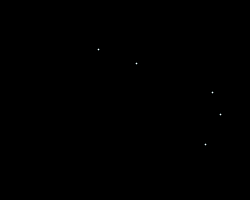
IFSs were conceived in their present form by John E. Hutchinson in 1981 and popularized by Michael Barnsley's book Fractals Everywhere.
1981年,约翰 · e · 哈钦森以现在的形式构思了 IFSs,并由迈克尔 · 巴恩斯利的著作《分形无处不在》而流行开来。1992年,斯科特 · 德拉维斯发明了分形火焰算法
Hutchinson (1981) showed that, for the metric space [math]\displaystyle{ \mathbb{R}^n }[/math], or more generally, for a complete metric space [math]\displaystyle{ X }[/math], such a system of functions has a unique nonempty compact (closed and bounded) fixed set S. One way of constructing a fixed set is to start with an initial nonempty closed and bounded set S0 and iterate the actions of the fi, taking Sn+1 to be the union of the images of Sn under the fi; then taking S to be the closure of the union of the Sn. Symbolically, the unique fixed (nonempty compact) set [math]\displaystyle{ S\subseteq X }[/math] has the property
- [math]\displaystyle{ S = \overline{\bigcup_{i=1}^N f_i(S)}. }[/math]
The set S is thus the fixed set of the Hutchinson operator [math]\displaystyle{ F: 2^X\to 2^X }[/math] defined for [math]\displaystyle{ A\subseteq X }[/math] via
- [math]\displaystyle{ F(A)=\overline{\bigcup_{i=1}^N f_i(A)}. }[/math]
The existence and uniqueness of S is a consequence of the contraction mapping principle, as is the fact that
- [math]\displaystyle{ \lim_{n\to\infty}F^{\circ n}(A)=S }[/math]
for any nonempty compact set [math]\displaystyle{ A }[/math] in [math]\displaystyle{ X }[/math]. (For contractive IFS this convergence takes place even for any nonempty closed bounded set [math]\displaystyle{ A }[/math]). Random elements arbitrarily close to S may be obtained by the "chaos game," described below.
Recently it was shown that the IFSs of noncontractive type (i.e. composed of maps that are not contractions with respect to any topologically equivalent metric in X) can yield attractors.
These arise naturally in projective spaces, though classical irrational rotation on the circle can be adapted too.[3]
The collection of functions [math]\displaystyle{ f_i }[/math] generates a monoid under composition. If there are only two such functions, the monoid can be visualized as a binary tree, where, at each node of the tree, one may compose with the one or the other function (i.e. take the left or the right branch). In general, if there are k functions, then one may visualize the monoid as a full k-ary tree, also known as a Cayley tree.
Constructions
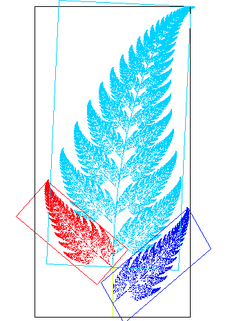
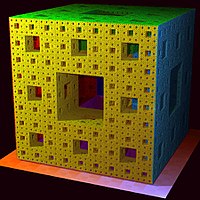
{{multiple image
| align =
| direction = horizontal
| width = 150
| header =
| image1 = Golden Square fractal 6.svg
Category:1981 introductions
类别: 1981年引言
This page was moved from wikipedia:en:Iterated function system. Its edit history can be viewed at 迭代函数系统/edithistory
- ↑ Zobrist, George Winston; Chaman Sabharwal (1992). Progress in Computer Graphics: Volume 1. Intellect Books. p. 135. ISBN 9780893916510. https://play.google.com/store/books/details?id=Ai6Qo0qoE9EC. Retrieved 7 May 2017.
- ↑ Michael Barnsley (1988). Fractals Everywhere, p.82. Academic Press, Inc. .
- ↑ M. Barnsley, A. Vince, The Chaos Game on a General Iterated Function System
